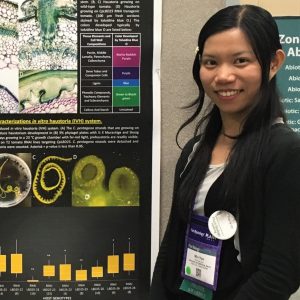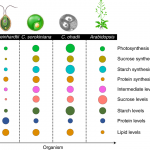Min-Yao Jhu: Plant Physiology First Author

 Min-Yao Jhu, first author of “Heinz resistant tomato cultivars exhibit a lignin-based resistance to field dodder (Cuscuta campestris) parasitism”
Min-Yao Jhu, first author of “Heinz resistant tomato cultivars exhibit a lignin-based resistance to field dodder (Cuscuta campestris) parasitism”
Current Position: Postdoctoral research associate at Crop Science Centre, Department of Plant Sciences, University of Cambridge, Cambridge, UK.
Education:
Ph.D. in Plant Biology, University of California Davis (UC Davis), CA, USA
M.S. in Plant Biology, National Taiwan University (NTU), Taiwan.
B.S. in Life Sciences, National Cheng Kung University (NCKU), Taiwan.
Non-scientific Interests: Ballroom dancing, yoga, painting, and baking.
Brief bio:
My interest in plant symbiosis is rooted in my academic study. From commensalism to parasitism, and then to mutualism, I have always been fascinated by how plants sense other organisms and establish a tight relationship with them.
My exploration began in 2009 when I joined Dr. Gwo-Ing Liao’s Lab studying cecidology. In my undergraduate research thesis, I investigated the morphological development of commensalistic insect galls. In 2012, I started my master’s research in Dr. Shih-Tong Jeng’s Lab at NTU and focused on wound-responsive microRNAs in sweet potatoes. Soon after that, I discovered that Dr. Neelima Sinha’s research group in UC Davis worked on parasitic plants and has used RNA interference as an effective biological control method against plant parasite infestation. Therefore, I started pursuing my Ph.D. degree in Sinha Lab at UC Davis (CA, USA) in 2015. My PhD research focused on haustorium development in Cuscuta campestris and the interaction between C. campestris and host plants.
After receiving my Ph.D. from the UC Davis in September 2021. I decided to join Dr. Giles Oldroyd’s research group and work on engineering nodule organogenesis in barley at the Crop Science Centre at University of Cambridge (Cambridge, UK). From parasitism to mutualism, I am looking forward to learning more about the signaling pathways that are involved in the development of lateral roots and nodules in order to engineer these mechanisms to support the interaction between nitrogen-fixing bacteria and cereal crops.
姓名:朱敏瑤
目前職位:劍橋大學作物科學中心博士後研究員
教育背景:加州大學戴維斯分校植物學博士,台灣大學植物科學碩士,成功大學生命科學學士
興趣愛好:國際標準舞、瑜珈、繪畫、烘培。
個人簡介:
我對於植物共生關係的興趣深深地影響了我的科研經歷。從片利共生到寄生,接著到互利共生關係,我一直以來對於植物如何感知其他生物並與其建立緊密的共生關係十分好奇並深感興趣。
2009年加入廖國媖老師的研究團隊參與癭學研究開啟了我的探索過程。我的學士論文進行片利共生昆蟲癭形態發育的研究。2012年,我有幸加入鄭石通老師的實驗室,開始我在台大的碩士研究。我當時的研究專注於甘藷中的傷害誘導小分子核糖核酸。投入這項研究後不久,我注意到了加州大學戴維斯分校Dr. Neelima Sinha的研究團隊正在進行寄生植物研究,並成功使用RNA干擾的生物控制方法有效的抵禦寄生植物侵襲。因此,在完成碩士學位後,我於2015年前往美國加州大學戴維斯分校在Sinha Lab開始攻讀博士學位,並且進行關於平原菟絲子吸器的發育研究以及平原菟絲子與宿主植物的交互作用。
2021年9月取得博士學位後,我決定加入Dr. Giles Oldroyd在英國劍橋大學作物科學中心的研究團隊並且針對大麥進行根瘤器官發育的轉基因工程研究。從寄生到互利共生,我期待能更了解側根與根瘤發育的機制,並且透過轉基因工程促進穀物作物與固氮根瘤菌的交互作用。



